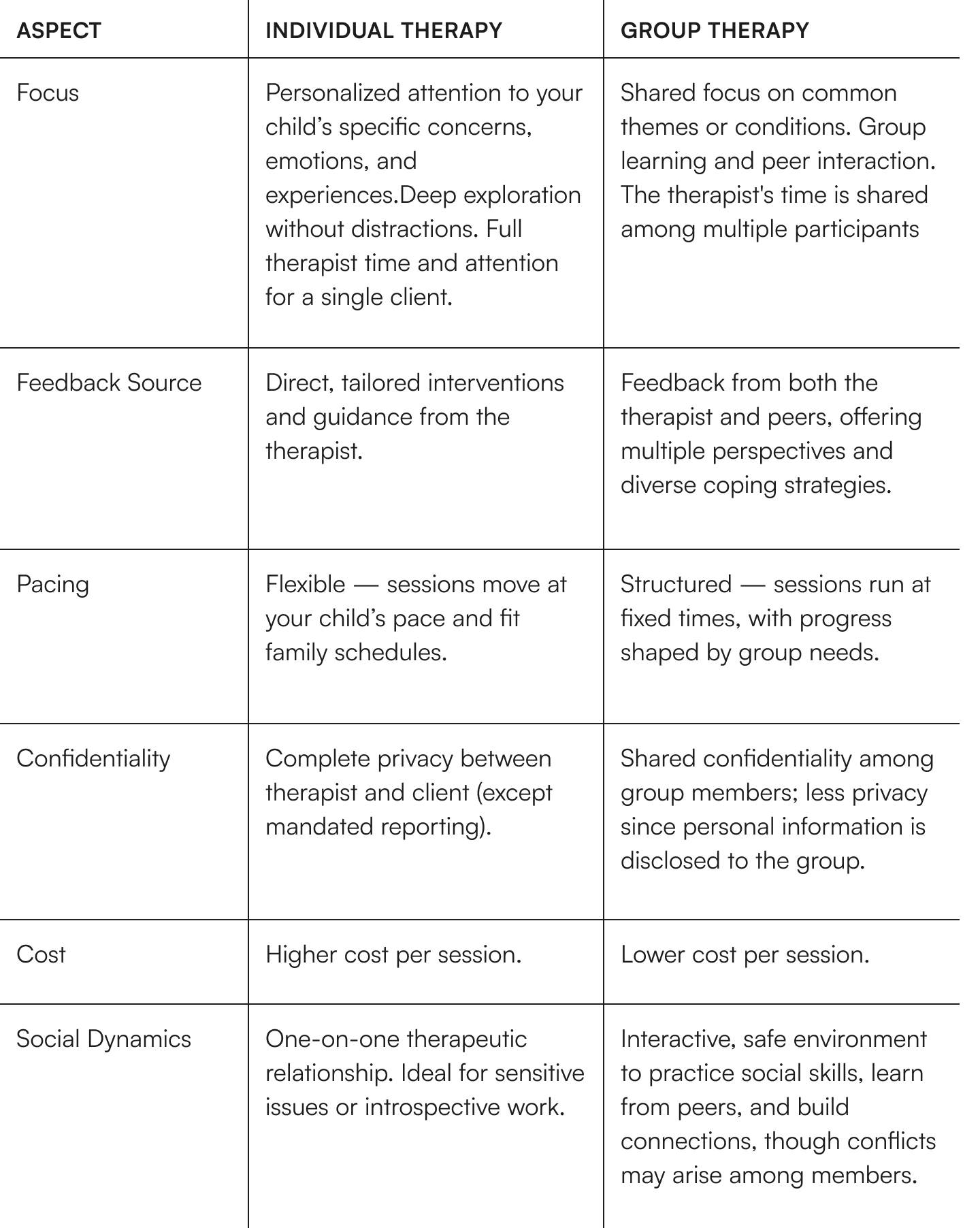Group vs Individual Therapy: Choosing the Best Format for Your Kid or Teen
Explore the pros and cons of group and individual therapy to find the best fit for your mental health needs. Read on to make an informed choice.


Growing up has never been easy, and today’s youth face pressures and challenges their parents never had to navigate. While therapy can benefit any young person, it becomes essential for those who are struggling.
Many parents exploring therapy wonder whether individual therapy or group therapy is the better fit for their child. Each offers unique benefits and may be more or less suitable depending on your child’s needs and preferences.
In this guide, we’ll compare the two side by side, outlining their benefits, drawbacks, and when a blended approach might be the most sensible choice.
Key takeaways
- Individual and group therapy each offer unique benefits. One provides personalized attention and privacy, while the other offers peer support, skill-building, and connection.
- The right choice depends on factors such as your child’s needs, comfort level, personality, budget, insurance coverage, and the availability of care.
- Virtual therapy platforms like Emora Health make care more affordable and accessible, offering both individual and group options to meet families where they are.
Side-by-side comparison: group vs individual therapy
Here’s a table for a side-by-side comparison of the two:

What is individual therapy?
Individual therapy (AKA talk therapy) involves one-on-one sessions between a young person and a licensed mental health professional in a private, confidential setting.
This can take place in person at a clinic or office, or virtually, both of which are equally effective. Virtual individual therapy sessions use secure video platforms that maintain the same therapeutic principles as in-person treatment in the comfort of your home.
Benefits of individual therapy for youth
Individual therapy provides several distinct advantages, particularly valuable for youth development.
- Customized care: The treatment plan is tailored to your child’s unique experiences and goals, providing them with support that truly meets their needs.
- Confidential space: One-on-one sessions offer a high level of privacy, so your child can open up without pressure, fear of judgment, or disclosure.
- Flexibility: Therapy moves at your child’s speed, which is especially helpful for those processing complex challenges or needing more time. Scheduling is also simpler without group coordination.
- Focused attention: With the therapist’s full attention, your child has space for deeper exploration of their thoughts, emotions, and behaviors.
- Strong therapeutic alliance: Young clients develop a trusting relationship with their therapist, which research has shown to be a major factor in treatment effectiveness.
Drawbacks of individual therapy
Despite its benefits, individual therapy presents certain limitations:
- Higher cost: Individual sessions typically cost more, especially without insurance, which can make consistent treatment harder to sustain.
- Limited peer support: Because the focus is one-on-one, teens miss the chance to learn from peers who face similar struggles. If the therapist relationship isn’t a good fit, your child may feel even less supported.
- Risk of isolation: Without group interaction, some teens, especially those coping with issues that benefit from social interaction to support their mental health needs, like poor self-esteem or grief, may feel more alone.
- Self-motivation required: Progress depends heavily on your child’s willingness to engage and follow through. Teens who struggle with motivation may find this more challenging without the built-in accountability of a group.
When to choose individual therapy
Individual therapy may be the best option for the following:
- Trauma or sensitive issues: Individual sessions provide the privacy needed to process experiences like abuse, grief, or identity concerns without fear of judgment.
- Severe mental health conditions: Disorders like severe depression and oppositional defiant disorder often require intensive, personalized care, including symptom management, thought regulation, and education about the illness.
- Readiness: Teens with high anxiety or those on the autism spectrum may find groups overwhelming at first. One-on-one sessions can help build basic social skills and confidence before transitioning to a group.
- Need for confidentiality: Sensitive concerns, such as bullying, substance use, family conflict, or identity, are often best addressed in the safe, private space of individual therapy.
- Flexible scheduling: Families with irregular schedules may find it easier to arrange one‑on‑one appointments than to commit to a fixed group meeting time.
What is group therapy?
Group therapy brings together 7 to 10 participants, accompanied by one or two group therapists. It uses the power of group dynamics to work through shared challenges, build skills, and gain a deeper understanding of mental health conditions.
Sessions are usually organized around a theme or condition common among participants, such as anxiety, depression, low self-confidence, or substance use.
Groups may focus on sharing experiences (process-oriented), learning coping strategies (psychoeducational), or practicing skills.
The format fosters peer connection, shared learning, and mutual support under the guidance of professionals.
Just like one-on-one sessions, group therapy can also happen online through secure video platforms. Kids still get the same interaction and support, with the added convenience of joining from home, without losing effectiveness.
Benefits of group therapy for kids and teens

The group setting offers unique advantages that support healthy youth development:
- Peer support: Knowing they’re not alone helps kids feel understood and less isolated, and gives them a network to lean on. This can be especially valuable for those facing anxiety, substance use disorder, depression, or similar struggles.
- Sense of belonging: Sharing similar experiences with peers fosters a sense of comfort and connection. This gives kids the courage to open up and seek help.
- Diverse perspectives: Discussing struggles and seeing issues from a different perspective can bring new insights and strategies that your child may not discover on their own.
- Social and communication skills: The interactive format helps kids practice self-expression, receive feedback, and build self-awareness in a supportive space.
- Cost-effective: Group sessions are usually more affordable, making consistent care more accessible.
Drawbacks of group therapy

Some kids may prefer individual therapy because of these challenges:
- Limited privacy: Sharing personal thoughts in a group can feel uncomfortable. Some children may hold back due to fear of judgment, lack of trust, or safety concerns.
- Less individualized focus: The therapist’s attention is divided among all participants, so specific issues may not always be addressed in depth or right away.
- Group dynamic issues: Differences in personality or communication styles can cause tension. Some kids may dominate discussions while others stay quiet, which can reduce group cohesion, one of the most important predictors of group therapy success.
- Scheduling constraints: Group therapy requires consistent attendance at set times, which may conflict with school, sports, or family commitments. Those with unpredictable schedules or transportation challenges may find this difficult.
When to choose group therapy
Group therapy may be a better fit for:
- Peer support and connection: Groups help teens feel less alone, build friendships, and find encouragement from others facing similar challenges, which is especially valuable for issues such as substance use, self-esteem, or social struggles.
- Interpersonal growth: The group setting is ideal for practicing communication, emotion regulation, and problem-solving while addressing unhealthy relationship patterns through feedback and modeling.
- Cost and access: Group therapy is usually more affordable and often easier to access than individual care. Telehealth groups also remove geographic barriers and reduce scheduling conflicts.
- Specific conditions: For challenges such as substance use, eating disorders, anxiety, and ADHD, groups not only provide shared learning and coping skills but also reduce stigma by showing kids they’re not alone.
Hybrid approaches: combining individual and group therapy
Many kids benefit from a combination of both formats. Individual sessions provide private space for personalized support, while group therapy offers peer connection, feedback, and opportunities to practice social skills. Together, they create a more complete support system.
Hybrid approaches can be sequential. For example, starting with individual therapy to address specific concerns, then moving into group therapy to practice skills and gain peer support. They can also be simultaneous, such as pairing individual sessions with specialized groups.
For instance, teens with social anxiety or ADHD work on personal challenges one-on-one and practice strategies in a group setting.
A well-known hybrid model is dialectical behavior therapy (DBT). Standard DBT combines weekly individual therapy, focused on reducing harmful behaviors and reinforcing skills, with group sessions that teach skills like mindfulness, distress tolerance, emotion regulation, and interpersonal effectiveness.
Cost considerations and insurance coverage
In the U.S., individual therapy typically costs $100–$250 per session without insurance, while group therapy averages $30–$80 (about half to three-quarters less) without insurance. Weekly sessions can add up quickly, often totaling hundreds per month.
Most insurance plans, including Medicaid, cover mental health care when a diagnosis is present, but coverage varies. Families may still be responsible for copays or coinsurance after their deductibles are met. In-network providers usually mean lower costs, while out-of-network care may require paying upfront and filing for partial reimbursement.
That’s why it’s important to verify your benefits before starting therapy by asking about coverage, copays, deductibles, and network status.
Providers like Emora Health make this process easier. We are in-network with most major insurance plans and can match you with a therapist covered by your insurance provider. Most families with insurance pay $0 – $35 per session. During signup, families get instant verification of benefits. You can use this page for real-time cost estimates.
How to choose the right format for your child
Choosing individual or group therapy often comes down to your child’s needs, personal preferences, and practical circumstances.
Consider:
Goals and concerns
Individual therapy is best for highly personal issues like trauma, grief, or building self-awareness, where privacy and depth are important. Group therapy is effective for addressing interpersonal issues, such as social skills development, relationship concerns, or peer support, as it provides teens with a supportive setting in which to practice and receive feedback.
Therapist recommendation
A therapist can assess your child’s needs, take your preferences into account, and recommend the format that’s likely to be most effective for their unique circumstances.
Comfort level and personality
Some teens feel most comfortable opening up in one-on-one sessions, while others may thrive in a group. For example, teens with strong social anxiety, starting one-on-one can feel less overwhelming.
In fact, a 2021 analysis of multiple clinical trials found that, overall, individual and group CBT worked about the same. But when the researchers looked just at adolescents, individual CBT came out ahead—helping teens lower their anxiety more than group sessions. Meanwhile, neither format showed a clear advantage for younger kids.
Socially motivated teens may find group therapy energizing and supportive, where they can practice skills and connect with peers. Readiness and motivation also matter: teens who are eager to engage may excel in groups, while those who require more time or privacy may progress better individually.
Practical considerations
Cost and insurance are major factors for most families. Whenever possible, look for a provider covered by your insurance to reduce out-of-pocket expenses.
Group therapy is often more affordable and may allow for longer-term participation, while individual therapy is more targeted but generally more expensive.
Scheduling also matters: group sessions run at set times, which can affect attendance, while individual therapy is more flexible.
Finding virtual therapy with Emora Health
Virtual therapy platforms like Emora Health make care more affordable and accessible without sacrificing quality. Emora Health specializes in online therapy for kids, teens, and young adults, offering both individual and group options through secure video sessions. Families are matched with vetted therapists who use evidence-based strategies, such as cognitive behavioral therapy, to help youth thrive.
In addition to therapy, Emora also provides ADHD and autism evaluations and medication management, with appointments often available within days and covered by most major insurers. This makes it easier for families to start care quickly from the comfort of their home.
Click here to start your search today and find a therapist who fits your child’s needs, personality, and insurance coverage.
- Chapman A. L. (2006). Dialectical behavior therapy: current indications and unique elements. Psychiatry (Edgmont (Pa. : Township)), 3(9), 62–68.
- Davenport, S. (2024, September 2). How Much Does Therapy Cost? A Guide. Medical News Today. https://www.medicalnewstoday.com/articles/how-much-does-therapy-cost
- Ezhumalai, S., Muralidhar, D., Dhanasekarapandian, R., & Nikketha, B. S. (2018). Group interventions. Indian journal of psychiatry, 60(Suppl 4), S514–S521. https://doi.org/10.4103/psychiatry.IndianJPsychiatry_42_18
- Greenwood, H., Krzyzaniak, N., Peiris, R., Clark, J., Scott, A. M., Cardona, M., Griffith, R., & Glasziou, P. (2022). Telehealth Versus Face-to-face Psychotherapy for Less Common Mental Health Conditions: Systematic Review and Meta-analysis of Randomized Controlled Trials. JMIR mental health, 9(3), e31780. https://doi.org/10.2196/31780
- Opland C, Torrico TJ. Psychotherapy and Therapeutic Relationship. [Updated 2024 Oct 6]. In: StatPearls [Internet]. Treasure Island (FL): StatPearls Publishing; 2025 Jan-. Available from: https://www.ncbi.nlm.nih.gov/books/NBK608012/
